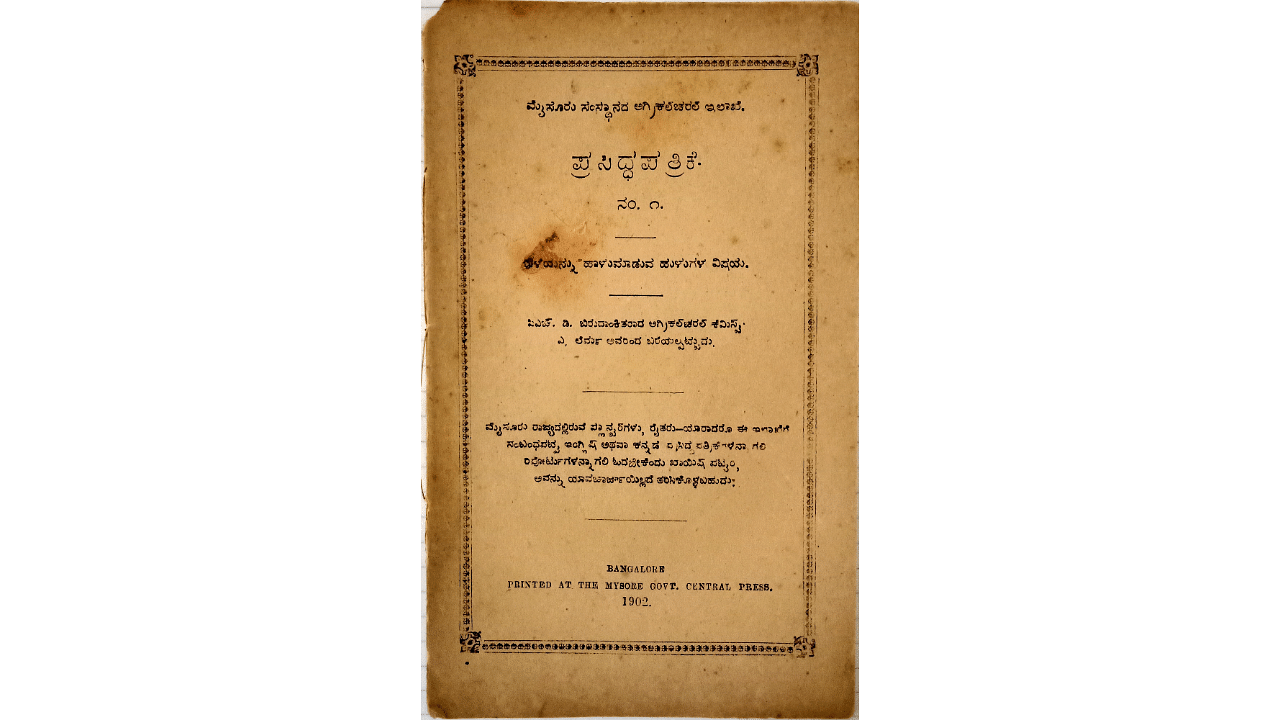
The cover of 'Prasiddha Patrike', published by Lehmann.
The field of agriculture developed phenomenally in 19th century Princely Mysore. Its beginnings can be traced back to the time of Tipu Sultan, who contributed much to its expansion. During the 18th century, many varieties of crops were introduced.
In 1831, Princely Mysore was brought under the direct administrative control of the British Commissioners. Much emphasis was given to agriculture. When Marc Cubbon was the Commissioner of Mysore, the ‘Horticulture Society’ was established. In 1857, it was renamed ‘Government Botanical Garden’.
During the late 1870s, the region witnessed severe drought and famine. Hence, priority was given to the cultivation of 'dry crops' like ragi, which would be sustained in dry conditions.
In 1881, Chamaraja Wadiyar X was crowned as the Maharaja. It was during his time that agriculture came to occupy a central role in the government. A department of agriculture came to be organised, constituted by international experts. As a result, very soon, Princely Mysore earned a name in the field of agriculture.
The government of the Maharaja of Mysore allocated huge tracts of land encouraging cultivation of coffee and dry crops. It also made allocations in its yearly budgets for extension of tanks and irrigation channels.
In 1899, Adolph Lehmann, an agricultural chemist from Canada was appointed by the government for his expertise. Lehmann carried out rigorous agricultural experiments by implementing various techniques. He also conducted several experiments to study soil fertility and made segregations of soil suitable for individual crops. He also conducted experiments in the cultivation of sugarcane.
When P N Krishnamurti was the Dewan of Princely Mysore, Lehmann wrote a working paper which was published in 1902 as ‘Prasidha Patrike’ in Kannada. It exclusively dealt with pests and their control. Also called ‘Notes on Entomology’, it was the first bulletin in a series. It later became a model for several such write-ups published by the Department of Agriculture.
Princely Mysore was also a pioneer in another aspect: Establishing the first agricultural experimental farm at Hebbal on the outskirts of Bangalore in 1904. Lehmann designed its buildings and landscape, which spread across an area of 80 acres. Here, experiments were conducted on wet crops like sugarcane and paddy, and dry crops like ragi, groundnut and castor seeds.
Entomology advances
In 1908, the department started the entomological section. In this department, Leslie Coleman was appointed as entomologist and mycologist. When Sir Visvesvaraya became the Dewan in 1914, a full-fledged department of agriculture was established. Coleman became its director later on.
To help farmers, the department established experimental farms at Maratur in Shivamogga district. From here, ‘Maraturu manure’ was produced. It consisted of a mixture of groundnut oil cake, sulphate of ammonia, potash and phosphate. Very soon, it became popular among farmers.
Adolf Lehmann.
Photo Credit: Wikimedia Commons
At Balehonnur, in present-day Chikkamagaluru district, a farm was set up to conduct experiments in coffee cultivation. A breeding station was established at Hunsur to research ragi.
Coleman contributed immensely to this field. He was responsible for printing and distributing bulletins and circulars on cultivation. A bulletin titled ‘Improvement of coffee industry in Mysore’ printed in English was priced at four annas then. The research station at Hebbal also printed calendars exclusively for farmers.
Leslie Coleman.
Photo Credit: Wikimedia Commons
Coleman published bulletins on various aspects of entomology, including the rice grasshopper. Later, in 1929, he published a note on behalf of The Mysore Agriculture and Experimental Union. In this note, he highlighted the success story of Princely Mysore — it had achieved a great deal of firsts in the field of agriculture.